
- Stock: 売り切れ
- Model: C30059
- サイズ: 107cm x 158cm
この絨毯の情報源は、Ian BennettとAziz Bassoulによる書籍『Tapis du Caucase – Rugs of the Caucasus』(2003、No.13)、Ian Bennettによる書籍『Oriental Rugs Volume 1 Caucasian』(1993、346ページ)、E. Gans-Reudinによる書籍『Caucasian Carpets』(1986、114ページ)です。これは19世紀末のカラチョフ・カザク地域、コーカサス地域の多重メダリオンデザインの絨毯です。カラチョフ(カラチョフまたはカラチョフとも表記されます)は、ロリ・パンバクの南東、カラクリスとイジェヴァンの間に位置する町です。この地域は大胆で壮大なデザインのカザク絨毯の一群を生み出し、特にトルコの絨毯であるチャナカレ・ベルガマグループに類似したものが最も特徴的です。それらはさらにクラシックなトルコの絨毯の一群である「大パターンのホルバイン」にまで遡ることができ、少なくとも15世紀のヨーロッパの絵画を通じて追跡できます。有名なカラチョフバージョンは、大きな中央の白地の八角形で、フィールドの四隅には白地の四角形が配置されます。主なフィールドの色は青、緑、青緑、または赤である場合があります。もう一つのより知られていないグループは、垂直軸に沿って配置された3つ、4つ、または5つのメダリオンを持つ絨毯で、メダリオンは多角形で、ヨムト・トルコメンの「ケプセ」グルに似ており、長方形または四角形の形状です。多角形のメダリオンはほとんど常に赤い地で、長方形のメダリオンは白い地です。主なフィールドの色は通常緑または青です。おそらく他のどのカザク絨毯よりもカラチョフ絨毯が保存されており、19世紀末から20世紀初頭にかけて、おそらく西洋への輸出を目的として相当数が織られました。この絨毯には多くの動物と人物の図柄があり、フレームには一連のボーダーが配置されています。この絨毯のデザインは、私たちのデザイナーによって解釈され、鮮やかな色が選ばれています
The source of the rug comes from the book Tapis du Caucase – Rugs of the Caucasus, Ian Bennett & Aziz Bassoul, The Nicholas Sursock Museum, Beirut, Lebanon 2003, nr.13 and Oriental Rugs Volume 1 Caucasian, Ian Bennett, Oriental Textile Press, Aberdeen 1993, pg.346 and Caucasian Carpets, E. Gans-Reudin, Thames and Hudson, Switzerland 1986, pg.114. This is a multiple medallion design rug from the late 19th century, Karachov Kazak region, Caucasus area. The town of Karachov (sometimes rendered Karatchoph or Karachoph) is southeast of Lori-Pambak, between Karaklis and Idjevan. It has given its name to a group of Kazak rugs with bold, majestic designs, the most characteristic of which resemble certain Turkish rugs, notably the Cannakale Bergama group, which, in turn, hark back to one of the most important groups of Classical Turkish carpets, the so-called ‘Large Pattern Holbeins’, which can be traced through European painting back to at least the 15th century. The well-known Karachov version consists of a large central white-ground octagon, flanked at the four corners of the field by four white ground squares; the main field color may be blue, green, blue-green, or red. A second and less well-known group consists of pieces with either three, four, or five medallions arranged along the vertical axis, the medallions being both polygonal, resembling the Yomut Turkoman ‘Kepse’ gül, and rectangular or square. The polygonal medallions almost always have red grounds and the rectangular ones white; the main field color is usually green or blue. Probably more Karachovs survive than any other group of Kazak rugs; they were obviously woven in considerable quantities in the late 19th and early 20th centuries, probably for export to the West. This rug has many animal and human figures and is framed with a series of borders. The design of the rug is interpreted by our designers, and vivid colors are chosen for this rug.
